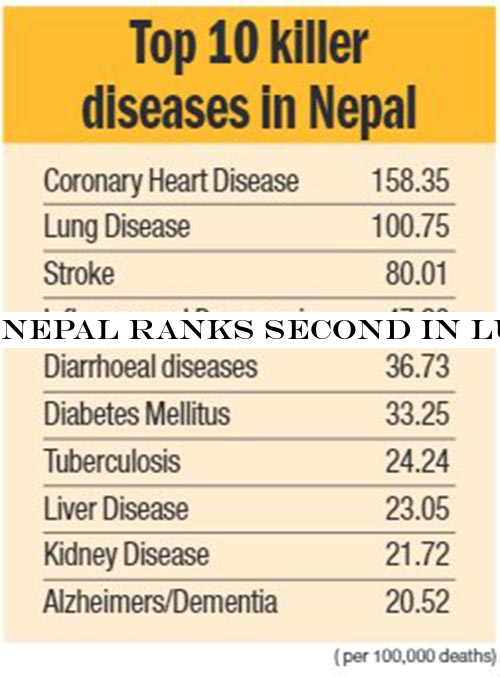Music
Trailers
DailyVideos
India
Pakistan
Afghanistan
Bangladesh
Srilanka
Nepal
Thailand
Iraq
Iran
Russia
Brazil
StockMarket
Business
CryptoCurrency
Technology
Startup
Trending Videos
Coupons
Football
Search
Download App in Playstore
Download App
Best Collections
Nepal
Kathmandu, August 11
On an average, of the 100,000 Nepalis who die every year, almost 101 die of lung diseases, making Nepal second only to Kazakhastan when it comes to deaths due to lung ailments. In Kazakhastan, of the 100,000 people who die every year, around 114 die of lung diseases, according to World Life Expectancy survey.
Lung diseases are the second highest cause of death in Nepal behind coronary heart disease, which is the biggest killer in the country. On an average, of the one lakh Nepalis dying every year, around 158.35 die due to coronary heart disease. Nepal is ranked 41st in the global league table of the rate at which the disease kills people.
The World Life Expectancy index was created using most recent data from sources likes the WHO, the World Bank, the UNESCO and individual country databases. The survey is based on 50 prominent ailments and accidents that claim lives of people in 183 countries.
Coronary heart diseases claimed 30,559 lives in 2017, accounting for approximately 19 per cent of total deaths caused by various diseases and accidents. As many as 19,274 people died of lung disease the same year, which makes up 11.81 per cent of total deaths in Nepal.
Dr Bishow Pokhrel, a cardiac surgeon and heart specialist, said changing lifestyle of people in Nepal has increased coronary heart patients. Coronary heart disease is related to blockage of major veins that join heart, which is the key reason of heart attack.
Dr Pokhrel suggested that regular exercise and balanced diet and avoiding excessive sweet, oil and salt could control the heart disease. He also suggested avoiding smoking, alcohol and avoiding exposure to polluted air could largely control lung diseases.
Among the top ten causes of deaths, stroke ranks third in Nepal, with 80.1 out of 100,000 people losing their lives to the disease. Next in the line are influenza and pneumonia, which take lives of 47.23 out of every 100,000 people. Diarrhoeal (36.73 people), diabetes (33.25 people), tuberculosis (24.24 deaths) and liver disease (23.05 people) come on the, fifth, sixth, seventh and eighth order, respectively.
Kidney disease stands ninth highest cause of death in the country and claims 21.72 lives every year, while Alzheimer/dementia has been categorised as the 10th highest cause of death with 20.52 people per 100,000 people.
Road accidents are 11th major reasons of death in the country. An average of 20.13 people out of 100,000 are killed in road accidents and Nepal stands at the 79th position in the world in deaths by road accidents.
HIV/AIDS is the 17th major cause of death in the country, which claims an average of 9.76 people out of 100,000. The number of females dying of this disease is remarkably higher than that of males with 15.54 and 4.67, respectively.
Nepal ranks third in the global ranking in terms of deaths attributed to Leishmaniasis, a disease that is spread by the bite of certain kind of sand-fly, and Encephalitis. Encephalitis kills an average of 3.38 people out of 100,000 people, while Leishmaniasis claims 1.28 lives. lives.
Despite growing deaths, Nepaliaverage life expectancy is improving over a period of last 29 years. The average life expectancy increased to 62.5 years in 2000s from 54.5 years in 1990s. And again rose to 68.0 years in 2010 and 70.2 years in 2016.
The National Planning Commission said the life expectancy of Nepalis will be 73 years in 2020.

The post Nepal ranks second in lung ailment deaths appeared first on The Himalayan Times.
- Details
- Category: Nepal
Read more: Nepal ranks second in lung ailment deaths
Write comment (92 Comments)Kathmandu, August 11
Tribhuvan University has decided to launch a four-year bachelorcourse in humanities from the next academic session that begins in September-October.
The decision to introduce four-year bachelorcourse was taken by the Faculty of Humanities and Social Sciences Education Council today.
&Other faculties of the university have already introduced four-year bachelorcourses,& said Shiva Lal Bhusal, dean of Faculty of Humanities and Social Sciences.
Govinda Prasad Sharma, assistant dean, FHSS said, &The introduction of a four-year course in humanities has ended dissimilarity of course duration at the bachelorlevel.&
&Employers are recruiting students who have completed four-year degree. Students of humanities were at a disadvantage because of the shorter duration of the course,& said Sharma.
This will also make TU courses on par with international courses. &Earlier students had to study additional one year when going abroad for studies. This four-year course will end such problems,& added Bhusal.
Four-year bachelorcourses have already been implemented in TUscience, management and education streams. &It was difficult for us to introduce the four-year course as there are a large number of subjects in the humanities stream,& said Sharma.
As many as 34 subjects are being taught in TUFaculty of Humanities and Social Sciences.
&Courses for all the subjects have already been designed and the curriculum will be made available online after we are done with official procedures,& said Sharma.
The course will be inter-disciplinary and students can study sociology, psychology, economics and other subjects within the same stream.
The university will also introduce Nepal Studies for the first time at the bachelorlevel as a compulsory subject to help students learn about Nepal. The subject will be taught in the fourth year. &Even after graduating many students lack basic knowledge about Nepal. We, therefore, have decided to introduce the subject to give students basic knowledge about history, geography, administration and culture of Nepal,& said Bhusal.
The four-year course will be of 2,000 marks (500 marks each year) and students can choose two subjects of 700 marks each as their majors and two subjects of 100 marks each as elective subjects.
There will be three compulsory subjects — English, Nepali and Nepal Studies. English will be of 200 marks, Nepali 100 marks and Nepal Studies 100 marks. English has been made compulsory in the first and third years, while Nepali will be compulsory in the second year.
The students will be evaluated on the basis of written examinations of 70 marks, while 30 marks will be for internal assessment, including mini project, classroom presentation and teamwork for each subject.
There are over 60,000 students in Tribhuvan University in its humanities programme.
The post TU starts 4-year bachelorin humanities appeared first on The Himalayan Times.
- Details
- Category: Nepal
Read more: TU starts 4-year bachelor’s in humanities
Write comment (96 Comments) Ghajinikanth (2019) New Released Hindi Dubbed Full Movie | Arya, Sayyeshaa, Sampath Raj, Sathish VideoLink: https://trailer.ecroaker.com/component/search/?videoid=cmIGczDZeCo
Ghajinikanth (2019) New Released Hindi Dubbed Full Movie | Arya, Sayyeshaa, Sampath Raj, Sathish VideoLink: https://trailer.ecroaker.com/component/search/?videoid=cmIGczDZeCo- Details
- Category: Nepal
 nepali prank - shoe maker || funny/comedy prank || epic reaction || alish rai || VideoLink: https://trailer.ecroaker.com/component/search/?videoid=KNyTwAWKmZs
nepali prank - shoe maker || funny/comedy prank || epic reaction || alish rai || VideoLink: https://trailer.ecroaker.com/component/search/?videoid=KNyTwAWKmZs- Details
- Category: Nepal
Read more: nepali prank - shoe maker || funny/comedy prank || epic reaction || alish rai ||
Write comment (96 Comments) U --I | Episode 24 | Feat Aashma Biswokarma |Saroj Adhikari VideoLink: https://trailer.ecroaker.com/component/search/?videoid=815vkxalcuI
U --I | Episode 24 | Feat Aashma Biswokarma |Saroj Adhikari VideoLink: https://trailer.ecroaker.com/component/search/?videoid=815vkxalcuI- Details
- Category: Nepal
Read more: U -I | Episode 24 | Feat Aashma Biswokarma |Saroj Adhikari
Write comment (99 Comments) MERO MAYA K HO - RATO TIKA NIDHAR MA || ANKIT SHARMA, SAMRAGYEE R.L SHAH || NISHAN, ASHMITA VideoLink: https://trailer.ecroaker.com/component/search/?videoid=R6lit8Lnf_o
MERO MAYA K HO - RATO TIKA NIDHAR MA || ANKIT SHARMA, SAMRAGYEE R.L SHAH || NISHAN, ASHMITA VideoLink: https://trailer.ecroaker.com/component/search/?videoid=R6lit8Lnf_o- Details
- Category: Nepal
Page 1438 of 1645

 10
10





